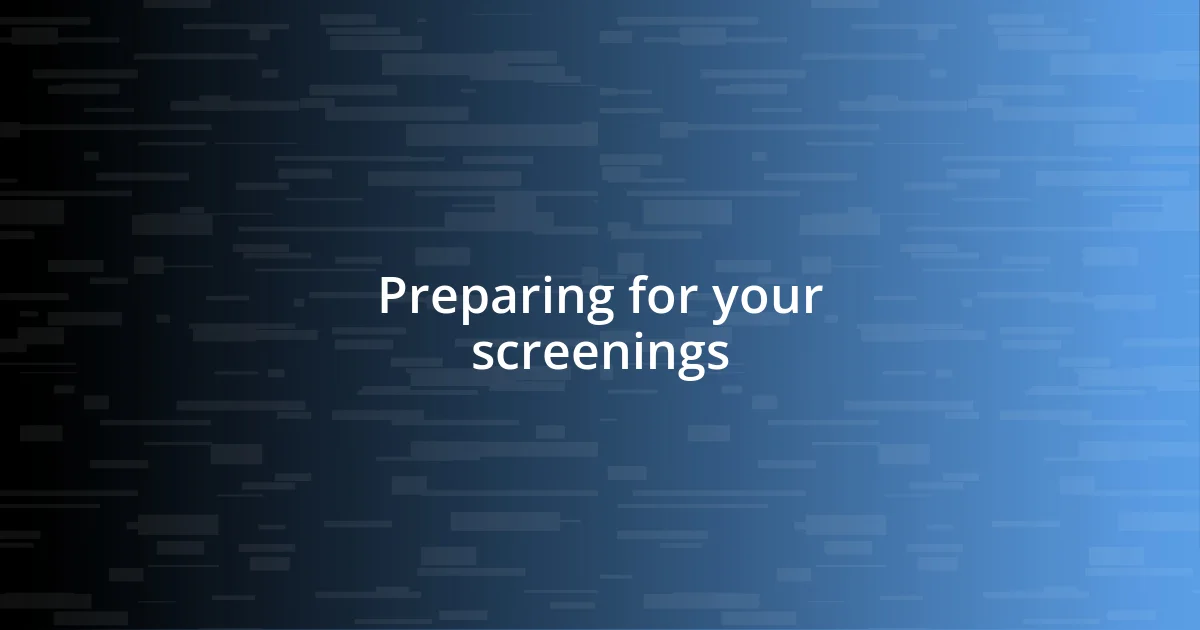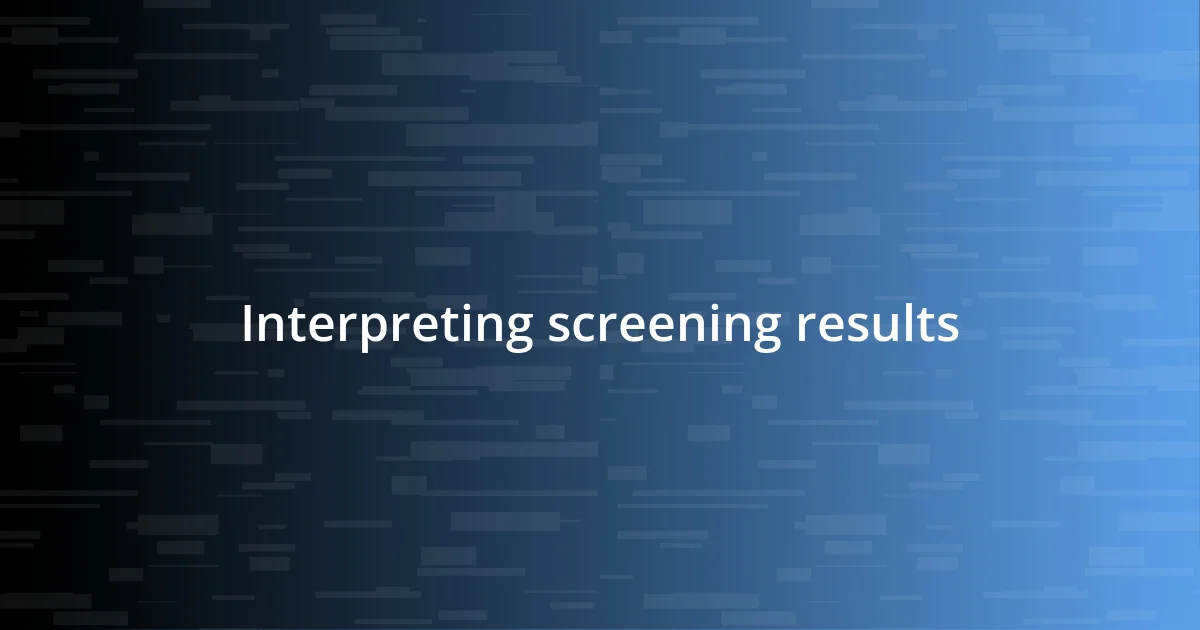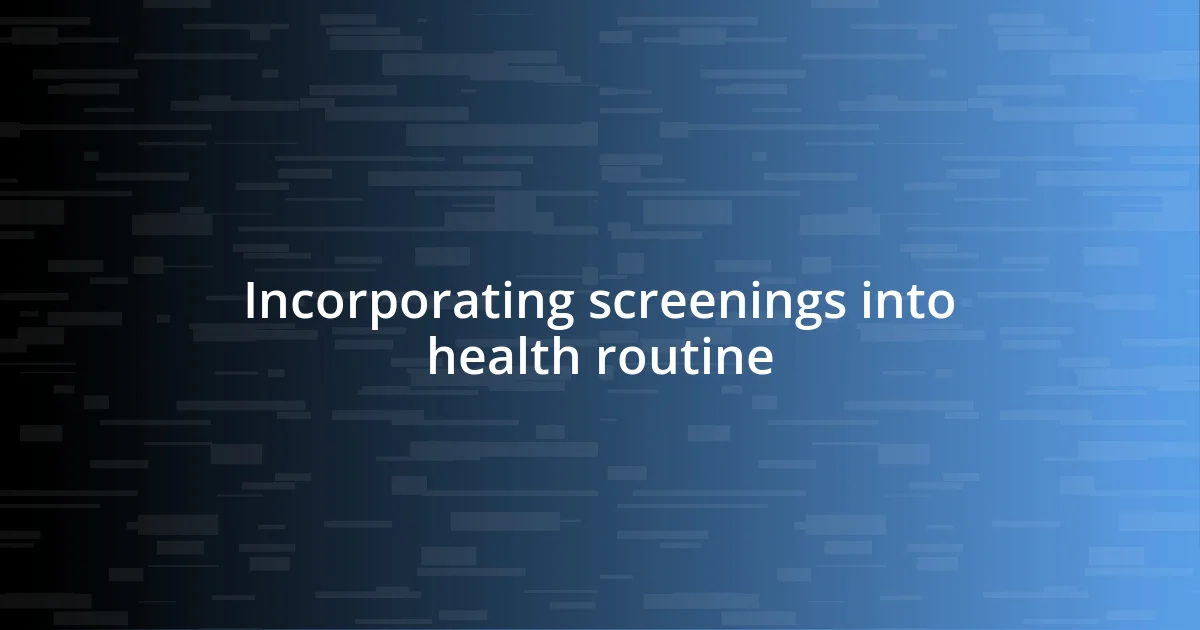Key takeaways:
- Preventive screenings, such as blood tests and imaging exams, are crucial for early detection of health issues, empowering individuals to take proactive control of their health care.
- Early detection significantly increases treatment options, improves prognosis, lowers costs, enhances quality of life, and provides peace of mind through timely intervention.
- Effective communication with healthcare providers, including sharing results and personal lifestyle habits, fosters a collaborative relationship that tailors care to individual needs.

Understanding preventive screenings
Preventive screenings are like a safety net, designed to catch potential health issues before they escalate. I remember my first mammogram—it was nerve-wracking, but knowing it could help catch something early made the anxiety worthwhile. Have you ever wondered how such small moments can have such a big impact on our health journey?
These screenings often include blood tests, imaging exams, and more, all aimed at identifying risk factors. The first time I got my cholesterol checked, I was surprised by the importance of that simple blood draw. It’s funny how something so quick can provide insights into how well your body is functioning, isn’t it?
What strikes me is how preventive screenings empower us to be proactive about our health care. I recall discussing my results with my doctor and feeling relieved to have a plan moving forward. Isn’t it reassuring to know that by taking these steps, you’re not just a passive participant in your health but an active agent in preserving it?

Importance of early detection
Early detection can dramatically change the outcome of many health conditions. I vividly recall receiving a call about my biopsy results; the waiting was agonizing, yet I felt a surge of gratitude knowing that I had taken the step to get screened. It was a stark reminder that the earlier we catch potential problems, the better equipped we are to tackle them head-on.
Consider these key benefits of early detection:
- Increased Treatment Options: The earlier a condition is identified, the more treatment options are often available.
- Better Prognosis: Many diseases, like cancer, have a much higher survival rate when caught in their early stages.
- Lower Treatment Costs: Early interventions can often prevent more expensive and extensive treatments later on.
- Enhanced Quality of Life: Detecting health issues early can lead to more effective management, resulting in a better quality of life overall.
- Peace of Mind: Knowing that you are on top of your health can significantly reduce anxiety around unknown health risks.
These aspects show just how pivotal early detection is in not just fighting diseases but also in maintaining a sense of control over our health journey.

Types of preventive screenings
Preventive screenings come in various forms, each tailored to detect specific health conditions before they can become serious. For example, annual physical exams usually include basic screenings like blood pressure checks and cholesterol levels, which I find invaluable for monitoring overall health. Once, during a routine check, I discovered my blood pressure was higher than normal—something I wouldn’t have known without that simple visit.
Another important type of screening is cancer screenings, which can take many shapes, from mammograms to colonoscopies. I vividly recall preparing for my first colonoscopy—it felt intimidating. However, a close friend reassured me how crucial it was for early detection, and I ultimately felt empowered. The results were normal, and that screening lifted a heavy weight off my shoulders. It reminded me how these procedures, though uncomfortable at times, are pivotal for peace of mind and health.
Screenings also encompass mental health assessments, which are gaining recognition in preventive care. I remember participating in a mental health screening at work and being surprised by how much self-reflection it prompted. Engaging with such tools can be a game-changer in identifying areas we might need to address. It’s remarkable how encompassing preventive screenings can be, impacting not just physical health but emotional well-being too.
| Type of Screening | Description |
|---|---|
| Routine Physical Exams | Includes checks for blood pressure, cholesterol, and other vital health indicators. |
| Cancer Screenings | Wide range of tests, like mammograms and colonoscopies, aimed at early detection of cancers. |
| Mental Health Assessments | Screenings focused on emotional well-being and psychological health, identifying areas needing support. |

Preparing for your screenings
Preparing for screenings can sometimes feel overwhelming, but I find that taking a few simple steps makes all the difference. I remember the first time I scheduled my mammogram; I was anxious and unsure of what to expect. But writing down my questions beforehand not only calmed my nerves but also empowered me during the appointment. Why not jot down your thoughts, too? Trust me, it’s a great way to ensure you get the most out of your time with your healthcare provider.
Another essential aspect of preparing for screenings is understanding the specific requirements for each type. For instance, I learned that fasting was necessary before my blood tests, which came as a surprise. Knowing these details ahead of time can help you avoid any last-minute stress or mishaps. Have you ever arrived unprepared? It’s a good reminder to check those requirements so you can walk into your appointment confident and ready.
I can’t stress enough the importance of mental preparation, either. When I was gearing up for my first colonoscopy, I turned to friends for support. Their honest experiences and shared tips eased my worries significantly. It’s a reminder that talking about your feelings or concerns can really lighten the emotional load. So, how do you prepare mentally for your screenings? Sharing experiences may just pave the way to a more positive mindset.

Interpreting screening results
Interpreting screening results can feel like navigating a foggy road, especially when you’re not sure what to expect. I clearly remember sitting in my doctor’s office, my heart racing as the results of a routine blood test were handed to me. The moment felt surreal—I scanned the paper, trying to decipher numbers and terminology I wasn’t familiar with. Thankfully, my doctor walked me through each result, helping me understand what each number meant for my health. Isn’t it comforting when a healthcare provider takes the time to clarify things for you?
Sometimes, though, screening results can bring unexpected news. After getting my cholesterol results back one year, I was shocked to see it was higher than what I anticipated. It felt daunting, leaving me with a whirlwind of emotions. But instead of panicking, I leaned into the conversation with my doctor, who outlined a plan for dietary adjustments and exercise. I learned that interpreting these results isn’t just about understanding numbers—it’s about the actionable steps that follow and how they can genuinely impact your life.
Equally important is the emotional journey that often accompanies interpreting these results. I recall a friend of mine who received mammogram results that required further testing. The anxiety during that waiting period was palpable. It made me realize that the interpretation of results isn’t just a medical task; it’s an emotional one too. How do we cope in those moments of uncertainty? I find it crucial to talk openly about such feelings, seeking support from friends or loved ones, to navigate the emotional landscape that sometimes comes with interpreting screening outcomes.

Incorporating screenings into health routine
Incorporating screenings into your health routine is a game-changer. I’ve found that setting aside specific times each year for my screenings makes it easier to prioritize my health. For example, I choose a month that works best for me—often when my schedule is lighter—so I can focus fully on my well-being without feeling overwhelmed by other commitments. Have you considered picking a dedicated time for your check-ups?
I remember creating a personal health calendar after realizing I was missing some crucial screenings. It was a simple move that brought clarity to my routine. By plotting out my screenings, I not only felt more organized but also instilled a sense of purpose in my health journey. Have you ever thought about how a little structure can make a big difference? You might be surprised by how effective a calendar can be in keeping you accountable!
I’ve learned that sharing my screening schedule with close friends encourages us all to stay on track together. Just the other day, I texted a close friend about my upcoming appointments, and she replied with her own plans! It was a delightful surprise and turned what used to be a solitary task into a communal experience. How much more motivating is it when we engage others in our health journeys?

Sharing results with healthcare providers
When it comes to sharing screening results, I’ve learned that clear communication with healthcare providers is essential. After receiving some concerning blood sugar levels, I found it beneficial to jot down my questions before the appointment. This way, I was prepared to discuss my results without feeling flustered. Have you ever walked into a doctor’s office only to forget the questions you intended to ask? I definitely have, and I realized that preparation empowers me in those moments.
During one particular visit, my doctor encouraged me to share not just my results but also my lifestyle habits. She said that understanding my everyday choices helped her tailor advice specifically for me. That conversation opened my eyes to the importance of context—it’s not just about the numbers, but also about my unique circumstances. It felt reassuring to contribute to my health narrative rather than simply being a passive participant. I wonder how many people miss out on this valuable exchange by not discussing their habits and feelings openly?
I also discovered that sharing results can foster a deeper bond with my healthcare provider. After expressing my fears about the implications of my screenings, I saw a shift in our conversation. Rather than just providing treatment options, she offered her personal insights, sharing how common my concerns were among her patients. This made me realize that vulnerability in these discussions can lead to more personalized care. Have you ever felt that connection with a provider after opening up? It can truly transform the experience into a partnership in health.












